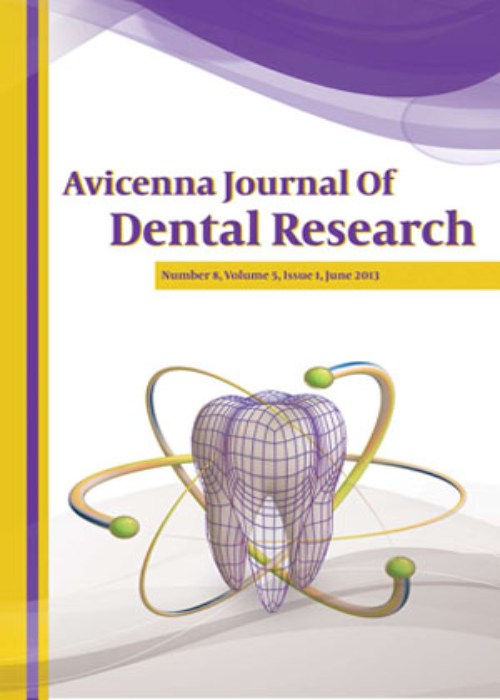فهرست مطالب
Avicenna Journal of Dental Research
Volume:4 Issue: 2, Jan 2012
- تاریخ انتشار: 1392/09/18
- تعداد عناوین: 5
-
-
Page 1Statement of the problem: Enamel white spot lesions are one of the problems associated with fixed orthodontic treatment that compromise esthetics.porpuse: The aim of this study was to evaluate the effect of fluoride varnish on the improvement of white spot lesions after fixed orthodontic treatment.Materials And MethodsIn this randomized clinical trial, 20 patients with at least two white spot lesions after fixed orthodontic treatment were selected and randomly divided into two groups. In the test group patients, VOCO fluoride varnish was applied to the buccal surface of all the teeth monthly for 4 months. Control group patients only received dental prophylaxis monthly for 4 months. At baseline, three photographs were taken from the frontal, right and left views of occlusion and repeated after 4 months. Pre- and post-treatment photos were superimposed using Photoshop 6.0 software and the area of demineralized white spot lesions was measured pre- and post-treatment. The measurements were compared with repeated measures ANOVA.ResultsThirty-three teeth in the test group and 32 teeth in the control group were evaluated. Oral hygiene was good in both groups. The mean size of lesions in the test group was 8.3%±3.07 before treatment, decreasing to 5.9%±2.9 after treatment (P=0.009). The mean size of lesions in the control group was 7.7%±4.2 before treatment, decreasing to 5.9%±3.6 after treatment (P=0.001). No statistically significant diffrences were detected between the two groups (P=0.307).ConclusionAccording to the results, use of fluoride varnish has no superiority over natural remineralization by saliva in decreasing white spot lesions in patients with good oral hygiene.
-
Page 10Statement of the problem: Using CBCT to determine root morphology minimizes rate of treatment failure and adverse effects, such as gouging and perforations.PurposeThe aim of this study was to assess morphology of root canals using CBCT scans.Materials And MethodsIn this cross-sectional study, conducted in the Radiology Department of Hamadan Dental School in 2011?2012, 66 CBCT scans were studied. The following data were analyzed: number of roots, canals, canal types and root canal curvature of mandibular central and lateral incisors, canines, first and second premolars and molars and maxillary first and second premolars and molars. Data was analyzed with SPSS 16.0 and descriptive statistical tests.ResultsIn this study, all the mandibular central and lateral incisors, canines, second premolars and most of the mandibular first premolars (98.5%) and all of the second premolars and maxillary first and second premolars (63.6% and 65.1%) had one root. All the mandibular first molars and most of the second molars (95.4%) had two roots. All the maxillary first and second molars had three roots. Most of the mandibular central and lateral incisors, canines and first premolars and maxillary second premolars had one canal. 65.1% of mandibular second premolars and 87.9% of maxillary first premolars had two canals. Most of the mandibular first and second molars and maxillary first molars had three and maxillary second molars had four canals. The majority of mandibular central and lateral incisors, canines, first and second premolars were type I. The majority of teeth, based on Dobo-Nagy classification, were type I (straight). Mandibular second molars had the majority of C-shaped (entirely curved) curvature.ConclusionCBCT scans are efficacious tools for the diagnosis of root canal morphology and curvatures to increase the success of root canal treatment
-
Page 17Statement of the problem: Tooth restorations are exposed to stresses which produce marginal gaps resulting in microleakage.PurposeIn this study, microleakage of light-cured glass-ionomer and compomer class V restorations was evaluted and compared under cyclic loading.Materials And Methodsclass V cavities were prepared on the buccal surfaces of maxillary premolars (n=40). The teeth were randomly divided into two equal groups. Samples in one group were restored with Compoglass and those in the other group were restored with Fuji II LC. All the samples were thermocycled for 2500 cycles. Each group was subjected to cyclic loading (10000 cycles). Dye peneteration method was used for samples. Finally, microleakage of the restorations was evaluated under a stereomicroscope at ×20. Data were analyzed with chi-squared test. The confidance level was set at 95% (α=5%).ResultsMicroleakage was observed at 55% of restoration margins with both materials, with more leakage in the Compoglass group. The results showed no statically significant differences between the two groups (P>0.05). In addition, no significant differences were seen in microleakage between gingival and occlusal margins (P=0.64 and P=0.7, respectively).ConclusionMicroleakage of Compoglass and Fuji II LC restorations was not different at margins under cyclic loading
-
Page 38Statement of the problem: The aim of this study was to compare the treatment outcome of CL I malocclusion patients treated by two methods, including Standard Edgewise and MBT.Materials And MethodsThirty subjects (23 boys and 7 girls) with an age range between 14?19 years were included in each group. The patients had Cl I malocclusion and were treated through Non-Ext strategy. Pre- and post-treatment records were assessed using the grading system of the American Board of Orthodontics (ABO). Eight parameters were measured three times and the mean of the three measurements was recorded. Finally, the score of each parameter as well as total score of all parameters (ABO score) were compared between groups by t-test.ResultsImprovement in ABO score between the two groups did not show significant differences. However, in details of post-treatment occlusion, such as buccolingual inclination, there was a significant difference between groups (P=0.014).


